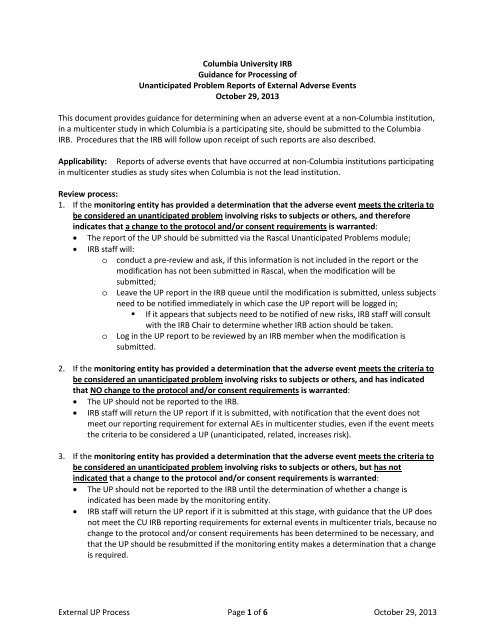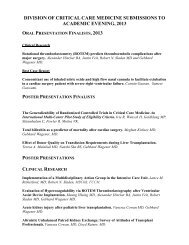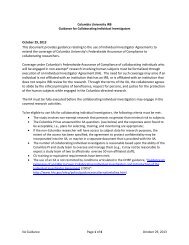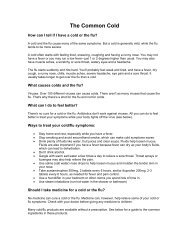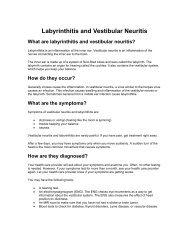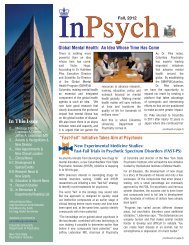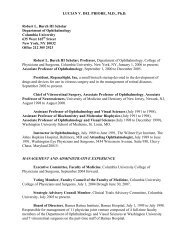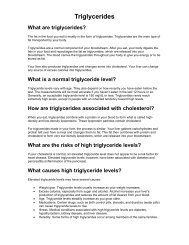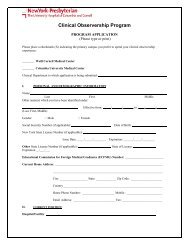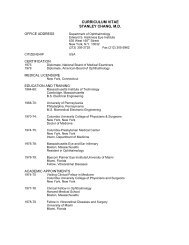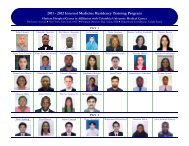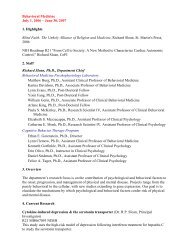Guidance for Unanticipated Problem Reports of External Adverse ...
Guidance for Unanticipated Problem Reports of External Adverse ...
Guidance for Unanticipated Problem Reports of External Adverse ...
You also want an ePaper? Increase the reach of your titles
YUMPU automatically turns print PDFs into web optimized ePapers that Google loves.
Columbia University IRB<br />
<strong>Guidance</strong> <strong>for</strong> Processing <strong>of</strong><br />
<strong>Unanticipated</strong> <strong>Problem</strong> <strong>Reports</strong> <strong>of</strong> <strong>External</strong> <strong>Adverse</strong> Events<br />
October 29, 2013<br />
This document provides guidance <strong>for</strong> determining when an adverse event at a non-Columbia institution,<br />
in a multicenter study in which Columbia is a participating site, should be submitted to the Columbia<br />
IRB. Procedures that the IRB will follow upon receipt <strong>of</strong> such reports are also described.<br />
Applicability: <strong>Reports</strong> <strong>of</strong> adverse events that have occurred at non-Columbia institutions participating<br />
in multicenter studies as study sites when Columbia is not the lead institution.<br />
Review process:<br />
1. If the monitoring entity has provided a determination that the adverse event meets the criteria to<br />
be considered an unanticipated problem involving risks to subjects or others, and there<strong>for</strong>e<br />
indicates that a change to the protocol and/or consent requirements is warranted:<br />
• The report <strong>of</strong> the UP should be submitted via the Rascal <strong>Unanticipated</strong> <strong>Problem</strong>s module;<br />
• IRB staff will:<br />
o conduct a pre-review and ask, if this in<strong>for</strong>mation is not included in the report or the<br />
modification has not been submitted in Rascal, when the modification will be<br />
submitted;<br />
o Leave the UP report in the IRB queue until the modification is submitted, unless subjects<br />
need to be notified immediately in which case the UP report will be logged in;<br />
• If it appears that subjects need to be notified <strong>of</strong> new risks, IRB staff will consult<br />
with the IRB Chair to determine whether IRB action should be taken.<br />
o Log in the UP report to be reviewed by an IRB member when the modification is<br />
submitted.<br />
2. If the monitoring entity has provided a determination that the adverse event meets the criteria to<br />
be considered an unanticipated problem involving risks to subjects or others, and has indicated<br />
that NO change to the protocol and/or consent requirements is warranted:<br />
• The UP should not be reported to the IRB.<br />
• IRB staff will return the UP report if it is submitted, with notification that the event does not<br />
meet our reporting requirement <strong>for</strong> external AEs in multicenter studies, even if the event meets<br />
the criteria to be considered a UP (unanticipated, related, increases risk).<br />
3. If the monitoring entity has provided a determination that the adverse event meets the criteria to<br />
be considered an unanticipated problem involving risks to subjects or others, but has not<br />
indicated that a change to the protocol and/or consent requirements is warranted:<br />
• The UP should not be reported to the IRB until the determination <strong>of</strong> whether a change is<br />
indicated has been made by the monitoring entity.<br />
• IRB staff will return the UP report if it is submitted at this stage, with guidance that the UP does<br />
not meet the CU IRB reporting requirements <strong>for</strong> external events in multicenter trials, because no<br />
change to the protocol and/or consent requirements has been determined to be necessary, and<br />
that the UP should be resubmitted if the monitoring entity makes a determination that a change<br />
is required.<br />
<strong>External</strong> UP Process Page 1 <strong>of</strong> 6 October 29, 2013
4. If the monitoring entity has not provided a determination that the adverse event meets the<br />
criteria to be considered an unanticipated problem involving risks to subjects or others:<br />
• The UP should not be reported to the IRB until the determinations <strong>of</strong> whether the AE is a UP and<br />
whether a change is indicated has been made by the monitoring entity.<br />
• IRB staff will return the UP report if it is submitted at this stage, with guidance that the AE does<br />
not meet the CU IRB reporting requirements <strong>for</strong> external events in multicenter trials, because it<br />
has not been determined to be a UP, and that the AE should be resubmitted if the monitoring<br />
entity makes a determination that the AE is a UP, and that a change is required.<br />
5. If the monitoring entity has provided a determination that the adverse event does not meet the<br />
criteria to be considered an unanticipated problem involving risks to subjects or others, and has<br />
indicated that NO change to the protocol and/or consent requirements is warranted:<br />
• The UP should not be reported to the IRB.<br />
• IRB staff will return the report if it is submitted, with guidance that the adverse event does not<br />
meet our reporting requirement because it is not considered a UP (unanticipated, related,<br />
increases risk).<br />
Monitoring<br />
entity<br />
determination<br />
<strong>of</strong> whether AE<br />
is UP<br />
Monitoring<br />
entity<br />
determination<br />
<strong>of</strong> whether<br />
change<br />
required<br />
Submit in<br />
Rascal?<br />
IRB staff processing if submitted<br />
1 Yes Yes Yes Check if mod also submitted; if no, ask when it is<br />
expected. Retain UP in the IRB queue if mod is not<br />
ready and subjects do not need to be notified <strong>of</strong> new<br />
or increased risks. Review UP and mod together if<br />
possible; review UP first if subjects need to be notified<br />
about increased or new risks<br />
2 Yes No No Return; advise that AE does not meet UP reporting<br />
requirements <strong>for</strong> external MC events<br />
IRB<br />
Chair or<br />
member<br />
review<br />
Yes<br />
N/A<br />
3 Yes None Not until<br />
determination<br />
is made<br />
4 None None Not until both<br />
determinations<br />
are made<br />
Return; advise to submit only if determination that<br />
change is required, and with mod in<strong>for</strong>mation<br />
Return; advise to submit only if determination <strong>of</strong> UP<br />
and that change is required, and with mod<br />
in<strong>for</strong>mation<br />
N/A<br />
N/A<br />
5 No No No Return; advise to submit only if determination <strong>of</strong> UP<br />
and that change is required, and with mod<br />
in<strong>for</strong>mation<br />
N/A<br />
IRB staff will consult with the respective IRB Chair if in<strong>for</strong>mation submitted in a UP report appears to<br />
indicate that actions different from the general guidelines above should be taken.<br />
Appendix A provides regulatory guidance regarding reporting external events.<br />
<strong>External</strong> UP Process Page 2 <strong>of</strong> 6 October 29, 2013
Appendix B provides sample correspondence that the IRB will use when returning reports to<br />
researchers.<br />
Appendix A: Regulatory <strong>Guidance</strong><br />
FDA guidance regarding external events (excerpts from guidance document):<br />
In general, an AE observed during the conduct <strong>of</strong> a study should be considered an unanticipated<br />
problem involving risk to human subjects, and reported to the IRB, only if it were unexpected, serious,<br />
and would have implications <strong>for</strong> the conduct <strong>of</strong> the study (e.g., requiring a significant, and usually safetyrelated,<br />
change in the protocol such as revising inclusion/exclusion criteria or including a new<br />
monitoring requirement, in<strong>for</strong>med consent, or investigator’s brochure). An individual AE occurrence<br />
ordinarily does not meet these criteria because, as an isolated event, its implications <strong>for</strong> the study<br />
cannot be understood.<br />
IND:<br />
In a multicenter study, it is clear that individual investigators must rely on the sponsor to provide them<br />
in<strong>for</strong>mation about AEs occurring at other study sites. It is also clear that the sponsor receives AE<br />
in<strong>for</strong>mation from all study sites and typically has more experience and expertise with the study drug<br />
than an investigator. Accordingly, the sponsor is in a better position to process and analyze the<br />
significance <strong>of</strong> AE in<strong>for</strong>mation from multiple sites and—when the determination relies on in<strong>for</strong>mation<br />
from multiple study sites or other in<strong>for</strong>mation not readily accessible to the individual investigators (e.g.,<br />
a sponsor’s preclinical data that supports the determination)—to make a determination about whether<br />
an AE is an unanticipated problem. Furthermore, the regulations require the sponsor <strong>of</strong> an IND to<br />
promptly review all in<strong>for</strong>mation relevant to the safety <strong>of</strong> the drug and to consider the significance <strong>of</strong> the<br />
report within the context <strong>of</strong> other reports (§ 312.32)7<br />
The regulations state that <strong>for</strong> studies conducted under 21 CFR part 312, investigators must report all<br />
"unanticipated problems" to the IRB (§§ 312.66, 312.53(c)(1)(vii), and 56.108(b)(1)). However, as<br />
discussed above, we recognize that <strong>for</strong> multicenter studies, the sponsor is in a better position to process<br />
and analyze adverse event in<strong>for</strong>mation <strong>for</strong> the entire study and to assess whether an adverse event<br />
occurrence is both unanticipated and a problem <strong>for</strong> the study.<br />
Accordingly, to satisfy the investigator’s obligation to notify the IRB <strong>of</strong> unanticipated problems, an<br />
investigator participating in a multicenter study may rely on the sponsor’s assessment and provide to<br />
the IRB a report <strong>of</strong> the unanticipated problem prepared by the sponsor. In addition, if the investigator<br />
knows that the sponsor has reported the unanticipated problem directly to the IRB, because the<br />
investigator, sponsor, and IRB made an explicit agreement <strong>for</strong> the sponsor to report directly to the IRB,8<br />
and because the investigator was copied on the report from the sponsor to the IRB, FDA intends to<br />
exercise its en<strong>for</strong>cement discretion and would not expect an investigator to provide the IRB with a<br />
duplicate copy <strong>of</strong> the report received from the sponsor.<br />
IDE:<br />
The investigational device exemption (IDE) regulations define an unanticipated adverse device effect<br />
(UADE) as “any serious adverse effect on health or safety or any life-threatening problem or death<br />
<strong>External</strong> UP Process Page 3 <strong>of</strong> 6 October 29, 2013
caused by, or associated with, a device, if that effect, problem, or death was not previously identified in<br />
nature, severity, or degree <strong>of</strong> incidence in the investigational plan or application (including a<br />
supplementary plan or application), or any other unanticipated serious problem associated with a device<br />
that relates to the rights, safety, or welfare <strong>of</strong> subjects” (21 CFR 812.3(s)). UADEs must be reported by<br />
the clinical investigator to the sponsor and the reviewing IRB, as described below:<br />
For device studies, investigators are required to submit a report <strong>of</strong> a UADE to the sponsor and the<br />
reviewing IRB as soon as possible, but in no event later than 10 working days after the investigator first<br />
learns <strong>of</strong> the event (§ 812.150(a)(1)).<br />
Sponsors must immediately conduct an evaluation <strong>of</strong> a UADE and must report the results <strong>of</strong> the<br />
evaluation to FDA, all reviewing IRBs, and participating investigators within 10 working days after the<br />
sponsor first receives notice <strong>of</strong> the effect (§§ 812.46(b), 812.150(b)(1)).<br />
The IDE regulations, there<strong>for</strong>e, require sponsors to submit reports to IRBs in a manner consistent with<br />
the recommendations made above <strong>for</strong> the reporting <strong>of</strong> unanticipated problems under the IND<br />
regulations.<br />
FDA guidance: http://www.fda.gov/downloads/RegulatoryIn<strong>for</strong>mation/<strong>Guidance</strong>s/UCM126572.pdf<br />
OHRP guidance regarding external events (excerpts from guidance document):<br />
The phrase “unanticipated problems involving risks to subjects or others” is found but not defined in the<br />
HHS regulations at 45 CFR part 46. OHRP considers unanticipated problems, in general, to include any<br />
incident, experience, or outcome that meets all <strong>of</strong> the following criteria:<br />
1. unexpected (in terms <strong>of</strong> nature, severity, or frequency) given (a) the research procedures that are<br />
described in the protocol-related documents, such as the IRB-approved research protocol and<br />
in<strong>for</strong>med consent document; and (b) the characteristics <strong>of</strong> the subject population being studied;<br />
2. related or possibly related to participation in the research (in this guidance document, possibly<br />
related means there is a reasonable possibility that the incident, experience, or outcome may<br />
have been caused by the procedures involved in the research); and<br />
3. suggests that the research places subjects or others at a greater risk <strong>of</strong> harm (including physical,<br />
psychological, economic, or social harm) than was previously known or recognized.<br />
OHRP recognizes that it may be difficult to determine whether a particular incident, experience, or<br />
outcome is unexpected and whether it is related or possibly related to participation in the<br />
research. OHRP notes that an incident, experience, or outcome that meets the three criteria above<br />
generally will warrant consideration <strong>of</strong> substantive changes in the research protocol or in<strong>for</strong>med<br />
consent process/document or other corrective actions in order to protect the safety, welfare, or rights<br />
<strong>of</strong> subjects or others.<br />
B. Reporting <strong>of</strong> external adverse events by investigators to IRBs<br />
Investigators and IRBs at many institutions routinely receive a large volume <strong>of</strong> reports <strong>of</strong> external<br />
adverse events experienced by subjects enrolled in multicenter clinical trials. These external adverse<br />
event reports frequently represent the majority <strong>of</strong> adverse event reports submitted by investigators to<br />
<strong>External</strong> UP Process Page 4 <strong>of</strong> 6 October 29, 2013
IRBs. OHRP notes that reports <strong>of</strong> individual external adverse events <strong>of</strong>ten lack sufficient in<strong>for</strong>mation to<br />
allow investigators or IRBs at each institution engaged in a multicenter clinical trial to make meaningful<br />
judgments about whether the adverse events are unexpected, are related or possibly related to<br />
participation in the research, or suggest that the research places subjects or others at a greater risk <strong>of</strong><br />
physical or psychological harm than was previously known or recognized.<br />
OHRP advises that it is neither useful nor necessary under the HHS regulations at 45 CFR part 46 <strong>for</strong><br />
reports <strong>of</strong> individual adverse events occurring in subjects enrolled in multicenter studies to be<br />
distributed routinely to investigators or IRBs at all institutions conducting the research. Individual<br />
adverse events should only be reported to investigators and IRBs at all institutions when a<br />
determination has been made that the events meet the criteria <strong>for</strong> an unanticipated problem. In<br />
general, the investigators and IRBs at all these institutions are not appropriately situated to assess the<br />
significance <strong>of</strong> individual external adverse events. Ideally, adverse events occurring in subjects enrolled<br />
in a multicenter study should be submitted <strong>for</strong> review and analysis to a monitoring entity (e.g., the<br />
research sponsor, a coordinating or statistical center, or a DSMB/DMC) in accordance with a monitoring<br />
plan described in the IRB-approved protocol.<br />
Only when a particular adverse event or series <strong>of</strong> adverse events is determined to meet the criteria <strong>for</strong><br />
an unanticipated problem should a report <strong>of</strong> the adverse event(s) be submitted to the IRB at each<br />
institution under the HHS regulations at 45 CFR part 46. Typically, such reports to the IRBs are submitted<br />
by investigators. OHRP recommends that any distributed reports include: (1) a clear explanation <strong>of</strong> why<br />
the adverse event or series <strong>of</strong> adverse events has been determined to be an unanticipated problem; and<br />
(2) a description <strong>of</strong> any proposed protocol changes or other corrective actions to be taken by the<br />
investigators in response to the unanticipated problem.<br />
When an investigator receives a report <strong>of</strong> an external adverse event, the investigator should review the<br />
report and assess whether it identifies the adverse event as being:<br />
1. unexpected;<br />
2. related or possibly related to participation in the research; and<br />
3. serious or otherwise one that suggests that the research places subjects or others at a greater risk<br />
<strong>of</strong> physical or psychological harm than was previously known or recognized.<br />
Only external adverse events that are identified in the report as meeting all three criteria must be<br />
reported promptly by the investigator to the IRB as unanticipated problems under HHS regulations at 45<br />
CFR 46.103(b)(5). OHRP expects that individual external adverse events rarely will meet these criteria<br />
<strong>for</strong> an unanticipated problem.<br />
OHRP guidance: http://www.hhs.gov/ohrp/policy/advevntguid.html<br />
*********************************************************************************<br />
<strong>External</strong> UP Process Page 5 <strong>of</strong> 6 October 29, 2013
Appendix B<br />
SAMPLE RETURN CORRESPONDENCE (IRB to Researcher, upon return <strong>of</strong> submission in Rascal)<br />
Return correspondence, if the monitoring entity has indicated that a) no changes to the protocol,<br />
IB/Instructions, and/or consent <strong>for</strong>m/process are warranted, and b) subjects do not need to be<br />
notified:<br />
As per current IRB procedures, *EXTERNAL* SAES only need to be reported to the IRB if they:<br />
A. Were unexpected<br />
B. Were related or at least possibly related to participation in the research<br />
C. Suggest that the research places subjects or other at greater risks <strong>of</strong> harm AND as such<br />
warrants changes in the research, Investigator Brochure, consent process or requires<br />
subjects to be notified.<br />
Please note that this decision is consistent with the OHRP and FDA guidance on reporting <strong>Unanticipated</strong><br />
<strong>Problem</strong>s Involving Risks to Subjects or Others and <strong>Adverse</strong> Events.<br />
Per the in<strong>for</strong>mation provided in the submission <strong>for</strong> this UP, this external SAE does not have an<br />
implication on the conduct <strong>of</strong> the research. There<strong>for</strong>e this UP is being returned to you <strong>for</strong> withdrawal.<br />
If additional in<strong>for</strong>mation becomes available that warrants changes in the research please re-submit.<br />
******************************************************************************<br />
Return correspondence, if the monitoring entity has not yet determined whether a) changes to the<br />
protocol, IB/Instructions, and/or consent <strong>for</strong>m/process are warranted, or b) if subjects need to be<br />
notified:<br />
As per current IRB procedures, *EXTERNAL* SAES only need to be reported to the IRB if they were:<br />
A. Were unexpected<br />
B. Were related or at least possibly related to participation in the research<br />
C. Suggest that the research places subjects or other at greater risks <strong>of</strong> harm AND as such<br />
warrants changes in the research, Investigator Brochure, consent process or requires<br />
subjects to be notified.<br />
Please note that this decision is consistent with the OHRP and FDA guidance on reporting <strong>Unanticipated</strong><br />
<strong>Problem</strong>s Involving Risks to Subjects or Others and <strong>Adverse</strong> Events.<br />
Per the in<strong>for</strong>mation provided in the submission <strong>for</strong> this UP, a determination has not yet been made by<br />
the monitoring entity regarding whether this external SAE has an implication on the conduct <strong>of</strong> the<br />
research. There<strong>for</strong>e this UP is being returned to you until such a decision is made. If additional<br />
in<strong>for</strong>mation becomes available that warrants changes in the research please re-submit.<br />
<strong>External</strong> UP Process Page 6 <strong>of</strong> 6 October 29, 2013


